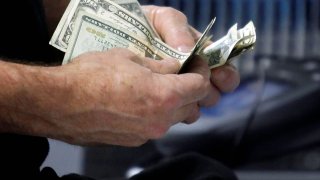
- Core personal consumption expenditures prices, excluding food and energy, rose 4.7% from a year ago, slightly less than expected.
- Headline inflation remained strong, rising 0.6% on the month and holding near the highest level since 1982.
- Disposable income and inflation-adjusted spending both declined on the month.
- Weekly jobless claims totaled 231,000, a slight decline from the previous period.
Inflation held at stubbornly high levels in May, though the monthly increased was slightly less than expected, according to a Commerce Department gauge closely watched by the Federal Reserve.
Core personal consumption expenditures prices rose 4.7% from a year ago, 0.2 percentage point less than the previous month but still around levels last seen in the 1980s. Wall Street had been looking for a reading around 4.8%.
On monthly basis, the measure, which excludes volatile food and energy prices, increased 0.3%, slightly less than the 0.4% Dow Jones estimate.
Get New England news, weather forecasts and entertainment stories to your inbox. Sign up for NECN newsletters.
Headline inflation, however, shot higher, rising 0.6% for the month, much faster than the 0.2% gain in April. That kept year-over-year inflation at 6.3%, the same as in April and down slightly from March's 6.6%, which was the highest reading since January 1982.
In addition, the report reflected pressures on consumer spending, which accounts for nearly 70% of all economic activity in the U.S.
Money Report
While personal income rose 0.5% in May, ahead of the 0.4% estimate, income after taxes and other charges, or disposable personal income, declined 0.1% on the month and 3.3% from a year ago. Spending adjusted for inflation fell 0.4%, a sharp drop from the 0.3% gain in April, though it was up 2.1% on a year-over-year basis.
"The rising cost of living absorbed all of the increased spending power from added jobs and higher wages in May," said Bill Adams, chief economist for Comerica Bank. "Americans are running faster just to stay even. No wonder consumer confidence is in the pits."
Goods inflation rose 9.6% while services prices were up 4.7%, both up 0.1 percentage point from April.
The personal saving rate edged higher, rising to 5.4%, up 0.2 percentage point from the previous month.
Fed officials are watching the data closely as they seek to control runaway inflation. Central bank policymakers generally watch core inflation more closely because they believe monetary policy is less effective at controlling the ups and downs of gas and grocery prices.
However, Fed Chairman Jerome Powell has said in recent days that he also is watching headline numbers closely as well as gas prices average about $4.86 a gallon.
The consumer price index, which measures a broad range of goods and services and is more closely watched by the public, rose 8.6% in May, its highest level since late 1981.
In other economic news Thursday, the Labor Department reported that jobless claims edged lower to 231,000 for the week ended June 25. That was a decline of 2,000 from the previous period though 1,000 higher than the estimate.
Continuing claims, which run a week behind the headline number, totaled 1.33 million, a slight decline from the previous week.






